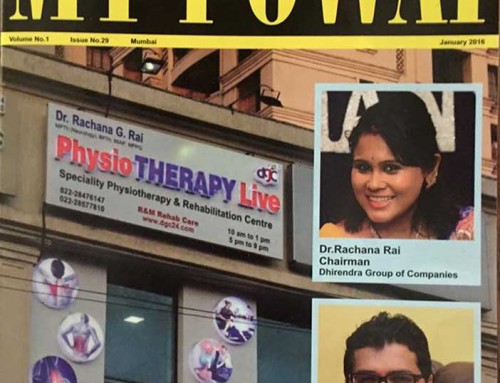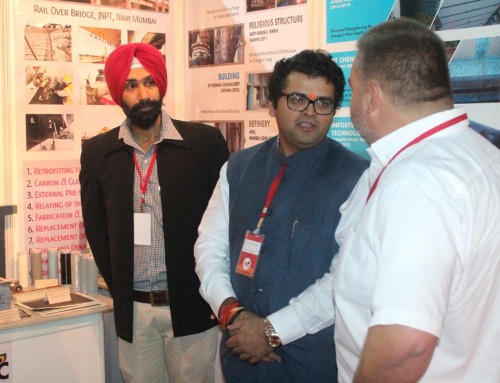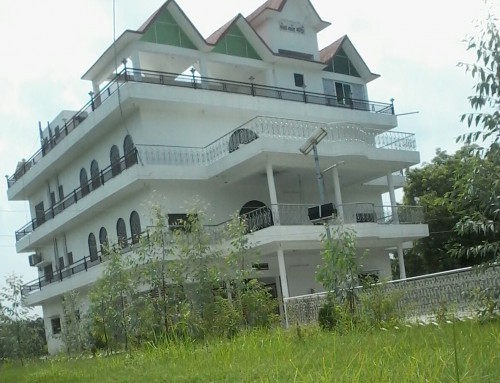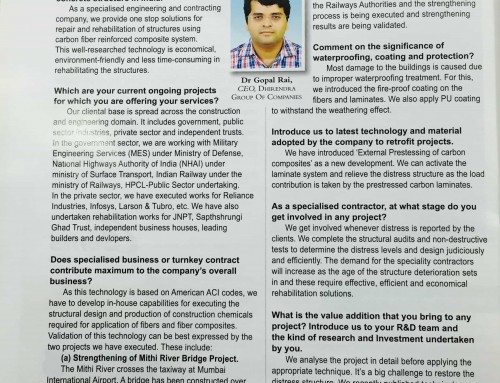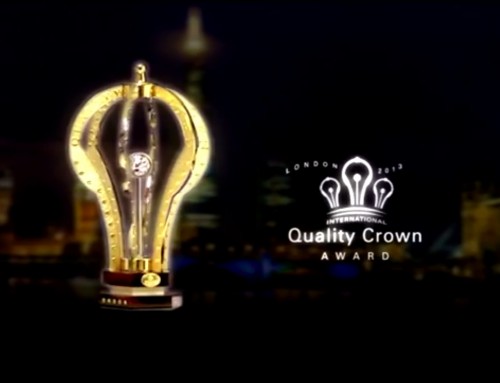In the next in a series of interviews with prominent civil engineers, JANAKI KRISHNAMOORTHI meets Dr Gopal Rai, CEO, Dhirendra Group of Company.
If you are proficient in your subject and believe in what you do, you should go ahead irrespective of what others say,” asserts Dr Gopal Rai, Chief Executive Officer, Dhirendra Group of Company. This has been his guiding principle in a career that is just a decade old. Focused on a specialised field—retrofitting and rehabilitation of concrete structures by composite materials—he has put several distressed structures and bridges back on their feet and enhanced the load capacity of others. His projects, which range from residential, commercial and heritage buildings to bridges, include the Mithi River runway bridge, railway over bridge at Dronagiri in Navi Mumbai and Syndicate Bank quarters in Ghatkopar, in suburban Mumbai.
Dr. Rai’s forte and his company’s core business is external pre-stressing using composite laminates, a new technology he developed while doing his doctorate at the Indian Institute of Technology (IIT) – Mumbai. “Bringing this technology to the industry was a big challenge,” states Dr. Rai, who even today spends around eight hours a month on research. “That is the only way I can upgrade my knowledge and techniques,” he says. “I am now working with several experts on various technologies related to civil engineering.”
His achievements today may come as a surprise to many as he was not considered a bright student in his schooldays! “I was more interested in playing and enjoying than studying,” he admits. “In ninth standard, I scored just 39 per cent and when I asked my father if I could become an engineer, he told me I would be lucky if I got a peon’s job. This remark by my father, who rarely scolded me on my poor performance, hurt me deeply and thereafter I began to study hard,” recalls the engineer whose education began at a municipal school in Chembur and ended at a prestigious institution like IIT. No doubt, he draws inspiration from his father, a schoolteacher who instilled the right values and direction in him. “Even when I fared poorly in my studies, he supported me and continued to motivate me in different ways,” says Dr. Rai, who is now building a beautiful bungalow in his native village Bhadohi in Uttar Pradesh, making his father’s dream come true.
Heading a Rs 30-crore business at the age of 35 and promoting lesser-known, less-tested technologies is no cakewalk. “Who will believe a 35-year-old talking about new, high engineering techniques?” asks Dr. Rai. “This is why I have tried to demonstrate the techniques, with trials sometimes at my own cost and by taking risky assignments. Many thought I was crazy!” In 2008, he constructed a three-storey building in Bengaluru, damaged it and then successfully retrofitted it with fibre-reinforced polymer (FRP) technology to demonstrate the effectiveness of the technology to the industry. It was Asia’s largest and a one-of-a-kind pushover test. Now, there is more awareness about FRP and more players are in the field. The specialised retrofitting industry has grown in the past five years from Rs 200 crore to Rs 1,000 crore, he reveals. So has his business. “I owe it all to my family who encouraged me wholeheartedly and to my team of 18 engineers—five of whom are IITians—labourers and well-wishers,” says Rai. Read on to learn more about his pet technologies, his experience and views:
Retrofitting remedy: Retrofitting is undertaken to strengthen an old building or bridge that is in distress to increase its lifespan; to enhance the load-bearing capacity of a structure when more floors are to be added; or upgrade the quality of construction that was originally poor. Retrofitting is also done to make buildings earthquake-resistant and energy-efficient or upgrade them to meet current norms. Traditionally, retrofitting was carried out with addition of new shear/infill walls, concrete/steel jacketing, propping up, casing, etc. Now, with the introduction of new materials and technology, new methods of retrofitting with many added advantages are available.
What we need: Retrofitting is a very vital component of civil engineering but it has not received its due in India. We are building and building but not looking at what will happen to the buildings after 10 years. We have to look at how the lifespan of these buildings can be enhanced, more so as we are going in for high rises that cannot be dismantled or demolished easily. We are not even training our engineers in retrofitting—it is not included in engineering courses in India, nor do we have any diploma courses. Only IIT – Chennai has introduced it in M Tech three years ago.
Technology take: Fibre reinforced composites (FRC) are among the new technologies available for repairs and retrofitting. Of the two forms of FRC, FRP wraps are more popular. Here, FRP sheets are wrapped around a reinforced concrete column, with fibres oriented perpendicular to the longitudinal axis of the column, and then fixed to the column using epoxy resin. The wrap not only provides passive confinement and increases concrete strength but provides significant strength against shear. Minimum surface penetration, resistance against corrosion, light weight, high strength-to-weight ratio, easy application, the requirement of fewer labourers and ease of transportation have made FRP popular.
Pre-stressing process: Pre-stressing technique using composite laminates is a very effective way to strengthen any structure but getting the laminates stressed and applied to the structural members is a challenging task. Pre-stressing is done in two ways. The first is by using FRC laminates that involves reinforcing beams externally and slabs from below with laminates, giving the members extra flexural and shear strength. The second method is column pre-stressing. We have developed an innovative technique and machinery for retrofitting columns and joints. It involves confining the column with carbon/epoxy or aramid/epoxy composite belts and pre-stressing it to confine the column in stressed position. The challenge here is to use these materials effectively. The use of pre-stressed laminates is suitable for bridges too. Whenever a structure is strengthened, if the strengthening material itself is heavy, it will increase the dead weight of the structure. Our technique hardly increases the weight as carbon is nine to 10 times lighter and five times stronger than steel. Using carbon composites is easy, fast and cost-effective.
Execution ethics: Retrofitting is a very challenging task; to execute it successfully one should follow certain rules. Designing is very critical and we should not play around with it. Second, visual inspection of the structure to be repaired is critical to understand the problems, what is causing them, and the mechanics of the structure. Drawings and designs are secondary, which are often unavailable anyway. But we have the technology and equipment to help us assess the situation like actuators, scanners, sensors, etc. For instance in a government building near Churchgate station in South Mumbai, the occupants suddenly found the building vibrating everyday between 2 pm and 5 pm. No one was able to determine the reason; some even blamed it on witchcraft! We were called to identify the cause. We monitored the building for a week with actuators, sensors and cameras and observed that the vibration was confined to one location. Further investigation at the location revealed that the new sewage pipe laid a year before was very close to the foundation and when there was maximum pressure on the pipe, it gave a thrust to the foundation, causing the vibration. We told BMC to shift the pipe 7-8 m away from the foundation. Conducting site tests after repairs is also essential to see if the retrofitting has yielded desired results. This will also help rectify any errors in the work before the client points it out.
Track record: Dr. Gopal Lalji Rai
Academic
- 2001 : BE (Civil), KESNNP Engineering College, Pen, Maharashtra
- 2003 : ME (Civil), Sardar Patel Engineering College, Mumbai
- 2005 : PhD (Structural Engineering), IIT – Mumbai
Professional
- 2006-2007: Product Manager – Repairs & Rehabilitation, BASF India, Mumbai
- 2007-2008 : Chief Executive Officer, S&P Clever Reinforcement Pvt Ltd, Mumbai
- 2008: Established DGC Infrastructure Pvt Ltd and later 21SHM Consultants Pvt Ltd and R&M Rasayana Pvt Ltd
- General Secretary, Association of Structural Rehabilitation; Joint Secretary, Indian Institution of Bridge Engineers; Member – Core Committee, Indian Society of Structural Engineers – Mumbai Chapter; Committee Member, Bureau of Indian Standards; Industry Partner, Federation of Indian Chambers of Commerce and Industry for Construction Chemicals
- Lecturer and Visiting Faculty at many institutions including IIT – Chennai and Sardar Patel College of Engineering, Mumbai
- Presented papers at over 60 seminars/conferences and published many papers in industry journals and magazines
Awards
FICCI Process Innovator of the Year in 2012 for innovation in the field of pre-stressed laminates used for strengthening and rehabilitation of structures
Challenging projects
PROJECT 1
Project: Strengthening Navi Mumbai SEZ (NMSEZ) Plaza, Dronagiri
Period: 2010-2013
Cost: Rs 3 crore
Client: Reliance Industries
Background: An existing 20-year-old building in Dronagiri, Navi Mumbai, was to be converted into a commercial plaza. The building had four blocks with over 300 beams each. “A study revealed that the beams and columns of the structure were deficient in their shear and flexural capacities to sustain the loading requirements of the proposed change in usage,” reveals Dr Rai. “Hence, it was decided to strengthen the building, starting with the D block.”
Solution: Considering various factors like time, usable space and budget, it was decided to use FRP systems for strengthening. While carbon fibre laminates were used for flexural enhancement, glass and carbon fibre wrapping on beams was used for shear enhancement. The structure primarily had three types of beams: waffle, frame and core beams. Waffle beams were strengthened with 50-mm-wide and 1.4-mm-thick pre-cured carbon fibre laminates with suitable anchorage at the ends and one single layer of glass fibre at L/3rd portions at the end for shear enhancement. Frame beams were strengthened with two or three 8-mm diameter carbon fibre rods or 20-mm-wide, 1.4-mm-thick laminates on the top in L/3rd portion from both ends with suitable anchorages as negative reinforcements and a single layer of glass fibre wrapping in L/3rd portions from both ends for shear enhancement. The core beams located in the lift area with higher load were strengthened by full wrapping of beam with single layer of carbon fibre wrapping, appropriate numbers of 8-mm diameter rods or 20/1.4-mm carbon laminates for support bending moment enhancement and 50/1.4-mm laminates below for mid-span bending moment enhancement. After successful completion of the D block in two months, work on other blocks was also completed using the same technique.
Challenges: Convincing the client about the new FRP technology was a challenge. “At that time, awareness about FRP was low and it was not widely used,” shares Dr. Rai. “But we managed to convince the client with projects carried out abroad and showcasing our own projects.”
PROJECT 2
Project: Retrofitting of rail over bridge (ROB), Uran
Period: 2010-2011
Cost: Rs 15 crore
Client: Jawaharlal Nehru Port Trust (JNPT)
Background: The 15-year-old ROB was showing distress signs owing to increased load, much more than it was originally designed to take. “An inspection of the bridge revealed that the expansion joints were not functioning properly, slab area of expansion joint was damaged severely and the gap between two spans had become significant and concrete had deteriorated,” reveals Dr. Rai. “Further, the neoprene/elastomeric bearings in the bridge were inadequate for heavy vehicle movements; there was a visible sag in the superstructure in many spans and typical structural failure cracks in the girders were observed.”
Solution: The girders and slabs were strengthened by placing additional steel truss systems to support the bridge deck/slab/girders with M32 high-strength bolts. The existing neoprene/elastomeric bearings were replaced by new elastomeric bearings. “The expansion joints were replaced with the Wabocrete strip seal expansion joint system, a superior system that can be rapidly installed in failed expansion joints and is suitable for heavy vehicle bridges,” explains Dr. Rai. “To further enhance the structural strength of the bridge, carbon fibre composite wrapping was done around the girder and slab. At the bottom of each girder, three pre-stressed carbon fibre composite laminates were placed.” The laying over the bridge was removed and relaying was done with structural repairs. The heavily damaged area in the vicinity of expansion joints were repaired with micro-concrete. The tests conducted after rehabilitation revealed that the solution was yielding desired results with ride quality and speed enhanced.
Challenges: The major challenge was implementing FRP technology on a bridge. “We had not applied this technology on a bridge until then,” says Dr. Rai. “Hence, we tested it on three spans of the bridge first and the results were good. Then, we implemented it on all the spans successfully.” Carrying out the work without stopping the traffic, which was one of the client’s conditions, was another challenge, more so as most of the traffic comprised trailers and container vehicles.
Award: The case study, Pre & Post Strengthening Testing of JNPT Bridge at Uran, won an award from Texas-based National Instruments Inc.
PROJECT 3
Project: Strengthening of Mithi River Runway Bridge under N1 taxiway at Mumbai Airport
Period: March 2012- April 2012;
Cost: Rs 2.87 crore
Clients: L&T and Mumbai International Airport Ltd (MIAL)
Background: Earlier designed for smaller aircraft, the bridge was inadequate to carry the load of the present aircraft and proposed changes in runway design. The multi-cell box, girder-type bridge had a taxiway, shoulder and service areas joined by expansion joints. A study revealed that the service area was deficient and needed strengthening.
Solution: The webs in the bridge were repaired with low viscosity grout and polymer-modified concrete. The strengthening included treatment of girders at mid-span for flexural enhancement, providing pre-cured carbon fibre laminate after casting the new RCC slab at the top. Flexure deficiency at support for inner webs was addressed by the new RCC slab cast at the top and reinforcements were provided to take care of the deficiency. Shear deficiency at the inner and outer webs was retrofitted with 430 gsm carbon fibre wrap in 0° direction and layer 990 gsm Glass fibre in 90° direction wraps over it. For cantilever spans, structural steel was placed at uniform spacing to support deficiency and transfer the load to the strengthened girders. For slab deficiency in shear in the cantilever portion, box MC 100 made by welding 2 ISMC 100 together was provided. These sections were prefabricated and coated with anti-corrosive, UV-resistant, PU-aliphatic coating. The manholes in the bays were strengthened with carbon laminate.
Challenges: The work had to be carried out from below the bridge as working above would have affected normal airport operation and raised security issues. Several safety and health hazards and access issues to work areas had to be tackled, like diverting the river water flow with bunds, removal of sludge, pesticide treatment, creation of ducts for accessing the webs to be strengthened, etc. “The 45-m-long access duct is a closed space with a height of just 4 ft where even standing was difficult,” explains Dr. Rai. “We had to ventilate it with a specially designed ventilation system. Each duct had four blowers sucking the bad air and pumping in fresh air and the air quality was monitored continuously. An ambulance and oxygen cylinders were kept as standby. As we had no way of contacting labourers who were inside the duct, as there was no mobile range either, we placed specially designed light sensors on their identity cards and monitored the situation inside with a specially designed monitoring system to avert any accidents. Despite all these issues, we completed the project without any accident and without compromising on quality in 29 days.”
Award: Won FICCI Process Innovator of the Year award.
Ref: http://www.constructionworld.in/News.aspx?nId=9IdAS3WvRLeGpGrCaMD3GA==


